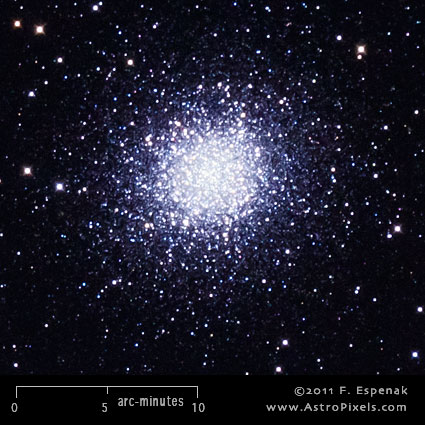
M13 - Great Hercules Globular
Messier 13 or M13 (also designated NGC 6205) is a globular cluster in the constellation Hercules. It has an apparent visual magnitude of 5.8 and its angular diameter is 16.6 arc-minutes. M13 lies at an estimated distance of 25,100 light years. The Equinox 2000 coordinates are RA= 16h 41.7m, Dec= +36° 28´ which makes M13 best seen during the summer. The Messier Summer Star Chart shows the position of all Messier objects visible during that season. As one of the more famous objects in the Messier Catalog, it is commonly known as the Great Globular Cluster in Hercules.
The image above shows the uncropped view of M13 through the Takahashi E-180 Astrograph (North is up). A 3x enlargement of this image appears to the right.
In spite of its inclusion in the Messier Catalog, this globular cluster was actually discovered by Edmond Halley in 1714. He noted that "it shows itself to the naked eye when the sky is serene and the Moon absent."According to Recio-Blanco et al.(2005), the distance of M13 is 25,890 light years and its diameter is 160 light years. Its estimated mass is 600,000 solar masses and it contains 40 variable stars. Arp (1962) estimates the age of M13 to be 14 billion years.
For more information, see the Messier Catalog as well as specific entries for M13 in Wikipedia and SEDS.
Messier's Description of M13
June 1, 1764
`Nebula without star, discovered in the belt of Hercules; it is round and brilliant, the center [is] more brilliant than the edges, one perceives it with a telescope of one foot; it is near two stars, the one and the other of 8th magnitude, the one above and the other below it: the nebula ['s position] was determined by comparing it with Epsilon Herculis. M. Messier has reported it on the Chart of the Comet of 1779, which was included in the volume of the Academy of that year. Seen by Halley in 1714. Reviewed Jan. 5 and 30, 1781. It is reported in the English Atlas Coelestis.' (diam. 6')
Technical Details
- Object: M13
- Other Names: NGC 6205, Great Globular Cluster in Hercules
- Object Type: globular cluster
- Object Data: Apparent Magnitude = 5.8, Angular Size = 16.6 arc-minutes
- Object Position (Equinox 2000): RA= 16h 41.7m, Dec= +36° 28´, Constellation = Hercules
- Date/Time: 2011 Apr 12 at 09:25 UTC
- Location: Bifrost Astronomical Observatory, Portal, AZ
- Mount: Astro-Physics 1200GTO
- Telescope: Takahashi Epsilon 180 Hyperbolic Astrograph
- Camera: Canon EOS 550D (Rebel T2i) (modified with a Baader UV/IR filter)
- Field of View: 1.70° x 2.56° at 1.7 arc-sec/pixel (web version: 10.0 arc-sec/pixel)
- Exposure: 2 x 300s, f/2.8, ISO 800
- File Name: M13-01w.jpg
- Processing (Adobe Camera Raw): Graduated Filter, Vignetting Correction, Noise Reduction, White Balance, Curves
- Processing (Photoshop CS5): Average Images, Curves, Noise Reduction
- Original Image Size: 3454 × 5179 pixels (17.9 MP); 11.5" x 17.3" @ 300 dpi
- Rights: Copyright 2011 by Fred Espenak. All Rights Reserved. See: Image Licensing.
